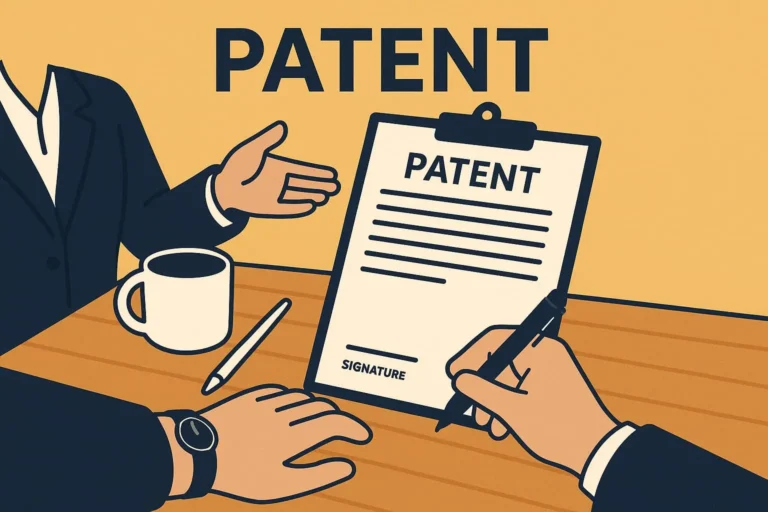The 5-Step DANIN Method: Create Perfect Information Disclosure Forms for Patents
Table of Contents
- Introduction: Why Your IDF Matters
- What is an Information Disclosure Form (IDF)?
- The 5-Step DANIN Method for IDF Creation
- Step 1: Draw – Make Drawings or Take Photos
- Real-World Example: Gas Stove Knob with Safety Features
- IDF Tips for Different Types of Inventions
- Conclusion: Maximizing the Value of Your IDF
Why should you read this complete guide on creating an Information Disclosure Form?
The Information Disclosure Form (IDF) is the foundation of your patent application. A well-prepared IDF helps your patent attorney or agent fully understand your innovation. Many inventors struggle with documenting their ideas effectively. In my years as a patent attorney, I’ve guided hundreds of inventors through the patent process. I’ve also conducted invention mining activities in large enterprises. One common challenge stands out. Inventors often provide very high-level details without proper linkage between components and functions. When these vague descriptions get reflected in patent documents, they lead to rejections during examination.
Inventors frequently hesitate to take the first step. They simply don’t know how to start documenting their ideas. Some are technical experts but struggle to explain their concepts clearly on paper. Others may understand their invention intuitively but find it difficult to break it down systematically.
The primary objective of this article is to help inventors capture invention details effectively. I’ll share practical knowledge from my experience as a patent attorney. To demonstrate this process, I’ve included one practical example from a client who successfully used this method.
What is an Information Disclosure Form (IDF)?
An IDF serves as a structured document that captures the technical aspects of your invention. It bridges the gap between your technical understanding and the legal requirements of a patent application. A well-prepared IDF ensures your patent attorney fully understands your concept without requiring multiple back-and-forth discussions.
Before exploring our practical example, let’s establish a clear framework for creating an effective Information Disclosure Form. The following 5-step methodology has proven invaluable for countless inventors in transforming their ideas into well-documented innovations ready for patent protection. Each step builds upon the previous one, creating a comprehensive documentation process that captures not just what your invention is, but how it works and why it matters. Whether you’re a first-time inventor or a seasoned innovator, these steps provide a structured approach that ensures no critical detail is overlooked when documenting your invention.
The 5-Step Method for Creating an Information Disclosure Form
DANIN (Draw, Assign Names, Number Parts, Illustrate Relation and Function, Novelty) Method for Creating an Information Disclosure Form
Step 1: Draw or Take Photos
Creating visual representations is the first critical step in your Information Disclosure Form. Your drawings should show all necessary views to explain your invention operation and use. For a complete IDF, include multiple angles such as front, side, top, and perspective views to give a comprehensive understanding of your invention external appearance. Don’t forget to showcase internal structure through cross-sectional views showing internal components that might not be visible from the outside. Assembly relationships are equally important – both assembled and exploded views help clarify how components fit together. If your invention has multiple operational states, include sequential drawings showing different positions or states to demonstrate functionality. Finally, add close-up views of important features or mechanisms that need special attention. These visuals form the backbone of your IDF. While professional-quality drawings aren’t required at this stage, ensure they’re clear enough for someone else to understand your invention’s structure and function.
Step 2: Assign names to components
For your Information Disclosure Form to be effective, each component must be clearly identified. Create a comprehensive list of every component visible in your drawings, using descriptive, functional names that indicate what each part does rather than generic terms. Maintain consistency with terminology throughout your IDF documentation to avoid confusion. Include even seemingly minor components, as these details may become important during patent examination or enforcement. Consider grouping related components logically (e.g., fastening elements, electronic components) to organize your documentation efficiently. This step of your IDF forces you to thoroughly analyze every aspect of your invention, often revealing opportunities for improvement or refinement that you might otherwise overlook.
Step 3: Numbers to Parts
Proper numbering is essential for a clear and professional Information Disclosure Form. Give each part a unique reference number for clear identification throughout your documentation. A good practice is to start with 100 or 1000 for the main assembly and increment by consistent intervals (e.g., 2, 5, or 10) for individual components, which allows you to add parts later if needed without disrupting your numbering scheme. For sub-components of a larger part, use decimal extensions (104.1, 104.2) or alphabetical modifiers (104a, 104b) to show hierarchical relationships. If your invention has multiple embodiments or configurations, consider using different number ranges for each version (100-199 for first embodiment, 200-299 for second, etc.) to clearly separate them. Creating a reference chart connecting part names to numbers provides easy tracking and ensures consistency throughout your documentation. This systematic numbering approach in your IDF allows for precise references and helps your patent professional understand component relationships without ambiguity.
Step 4: Illustrate Relation and Function
The written explanation is the heart of your Information Disclosure Form. Create a comprehensive description beginning with an overview of your invention and the problem it solves. Then dive into specifics.
Methodically describe each component. Detail its location relative to other parts and its function within the overall invention. Ensure consistency in terminology throughout your document. When you call something a “fastening arrangement” in one paragraph, don’t switch to “connector” or “attachment mechanism” elsewhere.
Explain how your invention works step-by-step. Follow logical operation sequences that a user would experience. Always reference the part numbers when mentioning components. If you’ve numbered a component as “sliding indicator slab (300)” in your drawings, always refer to it as “sliding indicator slab (300)” in your text.
Maintain this consistency with numerals too. Don’t interchange between “cavity (106)” and “cavity (160)” – such inconsistencies cause confusion and may weaken your patent application.
Include alternative materials, dimensions, or configurations where applicable. This provides breadth to your disclosure. If relevant, describe manufacturing methods or assembly procedures important to functionality.
Detail the operational use of your invention from start to finish. Cover all modes of operation or use cases. This section should be thorough enough that someone could understand and potentially reproduce your invention based solely on your description – essential for establishing proper patent protection.
In my experience with hundreds of inventors, this consistent linking between text descriptions and numbered components significantly improves patent quality and reduces examination rejections.
Step 5: Novel Aspects
The final crucial element of your Information Disclosure Form is a clear articulation of what makes your invention patentable. Begin by researching similar products or technologies to understand the current state of the art and position your invention within the existing landscape. Clearly articulate the specific improvements or unique features your invention offers compared to prior solutions. Describe the advantages these novel aspects provide—whether they improve functionality, efficiency, cost, safety, or user experience. Consider not just physical components but also new methods, combinations, or applications of known elements that create innovative results. Explain how your invention solves problems that existing solutions don’t address effectively, highlighting gaps in current technology that your invention fills. Identify potential commercial applications or market benefits to demonstrate the invention’s practical utility. This analysis helps your patent professional develop strong claims and determine the patentability of your invention, ultimately shaping the scope and strength of your patent protection.
Example: Creating an IDF for a Gas Stove Knob with Safety Features
Let me share with you a real-world example of creating an Information Disclosure Form. Recently, I worked with a client to document their gas stove knob with improved safety features. I’ll walk you through the exact process we followed, highlighting how we implemented each step of the DANIN method to create a comprehensive IDF that successfully captured the invention’s technical details.
Problem Identification
The first section of IDF is problem statement:
Conventional gas stove knobs provide limited visual feedback about burner states. Users often struggle to perceive whether the burner is on or off. This lack of clear indication can lead to accidental gas leakage when knobs aren’t fully turned to the off position, potentially resulting in dangerous gas accumulation, asphyxiation hazards, or even explosions and fires. You can also provide drawing of conventional device for better clarity by naming it as prior art.

Fig. 1 Prior art
Implementation of the DANIN Method
Step 1: Make Drawings for the IDF
For our gas stove knob Information Disclosure Form, we’ve created several drawings showing:

Step 2: Label All Parts in the IDF
In our Information Disclosure Form, we’ve identified these key parts:
- Base
- Knob lever
- Cavity in knob lever
- Window on top surface
- Sliding indicator slab
- First colored region (red)
- Second colored region (green)
Step 3: Assign Numbers to Parts in the IDF
Our Information Disclosure Form uses this numbering system:
- Knob (100)
- Base (102)
- Knob lever (104)
- Cavity (106)
- Window (202)
- Sliding indicator slab (300)
- First colored region (300a)
- Second colored region (300b)
Step 4: Explain the Drawings in the IDF
This section of our Information Disclosure Form provides a detailed description with respect to figures:
Fig. 1 illustrates the front view of knob in ON position.
Fig. 2 illustrates the front view of knob in OFF position.
Fig. 3 illustrates the perspective view of Sliding indicator slab.
Fig. 4 illustrates the working of Sliding indicator slab in ON position.
Fig. 5 illustrates the working of Sliding indicator slab in OFF position.
The knob (100) for controlling gas flow in a gas stove comprises a base (102) having a top plane and a bottom plane.
The knob also comprises a knob lever (104) rotatably enabled on the top plane of the base (102). The knob lever (104) has a cavity (106) and a window (106) on its top surface. the cavity (106) is configured to house a sliding indicator slab (300).
The sliding indicator slab (300) is rectangular in shape and configured to slide within the cavity (106) based on the angular rotation of the knob lever (104) between an on-state and an off-state. The sliding indicator slab (300) has a first colored region (300a) which is red and a second colored region (300b) which is green.
When the user rotates the knob lever (104) in a counterclockwise direction to turn on the stove, the sliding indicator slab (300) slides due to gravity such that the first colored region (Red) (300a) becomes visible through the window (108).
Conversely, when the user rotates the knob lever (104) in a clockwise direction to turn off the stove, the sliding indicator slab (300) slides again due to gravity, positioning the second colored region (Green) (300b) to be visible through the window (108).
Step 5: Identify Novel Aspects in the IDF
Our Information Disclosure Form concludes by highlighting these innovative features:
“The novelty lies in the use of a sliding indicator mechanism that provides enhanced visual feedback about the burner’s state. While conventional gas stove knobs have been around for decades, the integration of a gravity-operated sliding color indicator is an innovative approach to solving the ambiguity in knob positioning.
Specific novel points include:
- The sliding indicator slab that moves based on knob rotation
- The color-coded visual feedback system (red for “on” and green for “off”)
- The gravity-assisted movement that requires no additional power source
- The window design that clearly displays the current state
The advantages of this invention include:
- Enhanced visual feedback reduces user confusion about gas flow status
- Improved safety by clearly indicating when the gas is completely shut off
- Intuitive color coding follows universal conventions (red for danger, green for safe)
- Simple, cost-effective design with no electrical components required
- Clear indication helps prevent dangerous gas leakage from improperly closed knobs”
Information Disclosure Form Tips for Different Types of Inventions
While our example focused on a mechanical invention, the Information Disclosure Form approach can be adapted for various invention types:
For Electronic Devices:
- Include circuit diagrams and component connections
- Detail signal flows and processing steps
- Explain input/output relationships and user interfaces
For Software Innovations: To know more you can read the article of how to patent software inventions.
- Provide flowcharts and algorithm descriptions
- Include screenshots of user interfaces
- Describe data structures and processing methods
For Chemical Compositions:
- List ingredients and their proportions
- Detail manufacturing processes and reaction conditions
- Explain physical properties and applications
For Medical Devices:
- Show construction and assembly details
- Describe usage procedures and patient interfaces
- Explain therapeutic mechanisms and benefits
Conclusion: Maximizing the Value of Your Information Disclosure Form
Creating a comprehensive Information Disclosure Form using the 5-step DANIN method provides numerous benefits throughout your patent journey.
The process organizes your thoughts and clarifies your invention concept. It transforms abstract ideas into concrete, well-defined innovations. In my practice, I’ve seen inventors gain new insights about their own creations during this documentation process.
You can refine your invention and strengthen its patentable features early. One client discovered a critical safety feature while documenting their gas stove knob that became a key patent claim.
By providing your patent professional with complete information upfront, you enable them to develop stronger applications. My clients who follow this method typically see fewer office actions during examination.
The thoroughness reduces costs significantly. It minimizes the back-and-forth communications that occur when patent attorneys must extract additional details through multiple interactions. One corporate client estimated saving 30% in patent prosecution costs after implementing this documentation method. Their patents were granted with fewer office actions, and in some cases, the hearing was not scheduled as the patent was granted without extensive examination due to the strong foundation laid by the comprehensive IDF. A well-crafted IDF strengthens your application by thoroughly documenting all aspects. This increases the likelihood of successful prosecution and robust protection. The rejection rate for applications based on comprehensive IDFs is notably lower in my experience.
Beyond patents, your IDF creates a valuable record for future reference and potential investors. It serves as a comprehensive technical document demonstrating your invention’s value and your attention to detail. Several startup clients have successfully used their IDFs in investor presentations.
This systematic approach ensures your Information Disclosure Form serves as a solid foundation for your patent application. It gives your invention the best possible protection while creating a valuable business asset.
By following these guidelines, even first-time inventors can create professional-quality documentation that effectively communicates their innovations and streamlines the patent process. The result is more efficient patent prosecution and stronger intellectual property protection.






